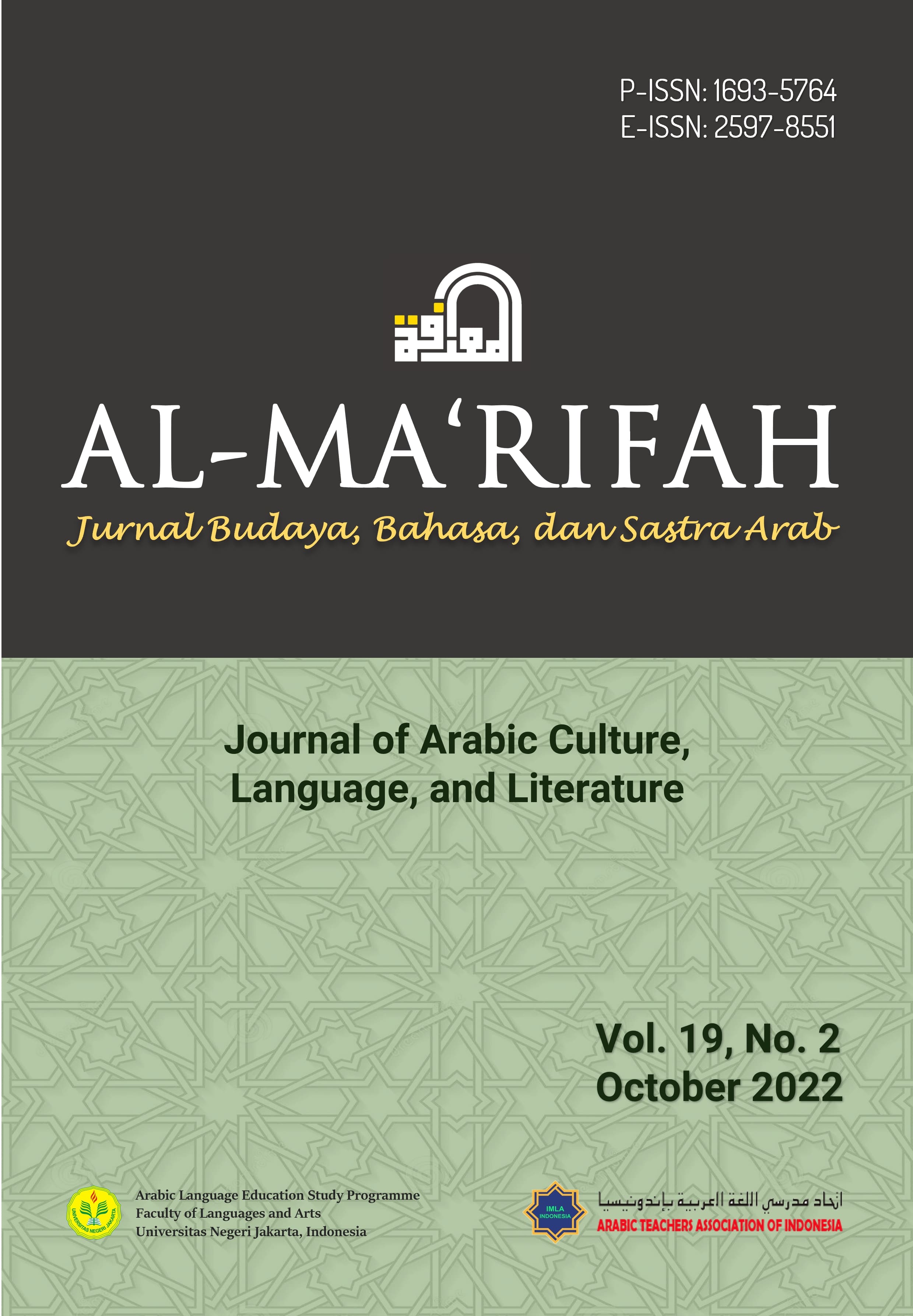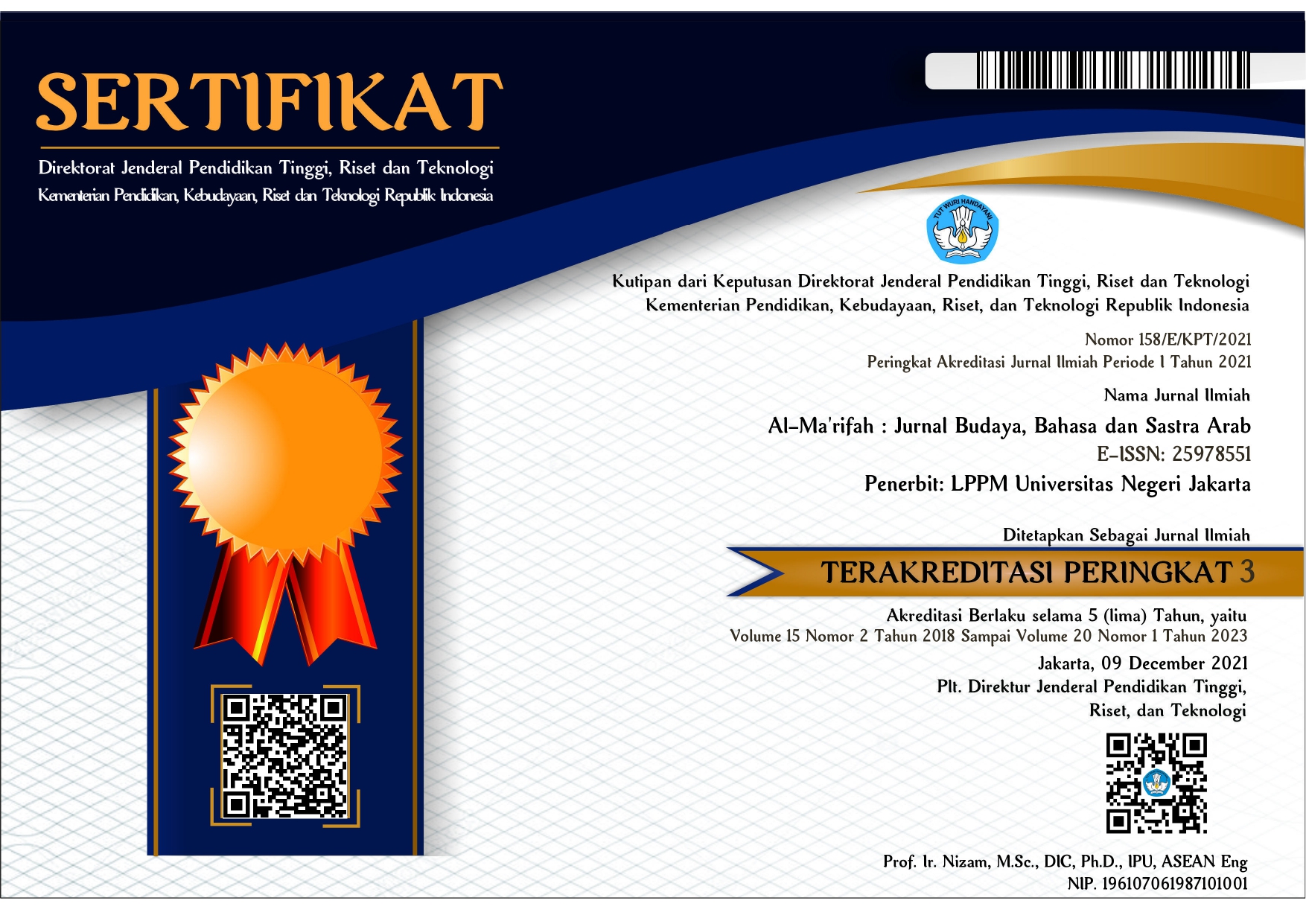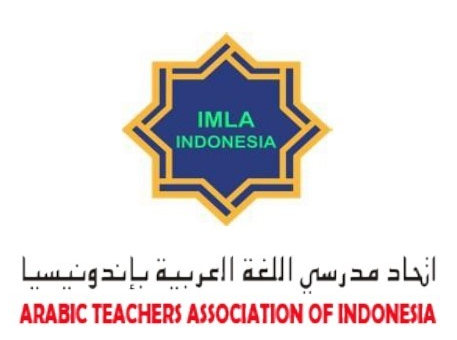The Arabic Discourse Markers in the Short Story Arnūb wa-al-Kasl by Aḥmad Samīr
DOI:
https://doi.org/10.21009/almakrifah.19.02.01Keywords:
discourse markers, Arabic short story, Arabic languageAbstract
Literature is an expression of art through language media. In general, literary works in Arabic are divided into three, namely prose, poetry, and drama. One of the prose literary works is short story. Discourse markers, which can be words or sentences, are important in generating coherent parts of literature discourse. In this study, the researchers will examine the discourse markers in the short story entitled “Arnūb wa-al-Kasl” written by Aḥmad Samīr (2008). The method used in this study is a descriptive qualitative in which the researchers as the main instrument aimed to describe the Arabic discourse markers used in the short story. The results of this study showed that the following are the discourse markers used in the story: wāw (‘aṭaf and isti’nāf), innā wa-akhawātuhā, kamā, fā’ [‘aṭaf] and ba‘da. For the wāw, it was found 8 words, for innā wa-akhawātuhā it was found 5 words, and for ba‘da it was found in 2 words.
References
Abū Ḥāqah, Ḥāwī, I., & Ilyās, J. (1997). al-Mufīd fī al-adāb al-‘Arabī. Beirut: Dār al-‘Ilm li-al-Malāyīn.
Adai, S. M., & Majeed, S. (2020). The use of discourse markers in Iraqi Arabic: A pragmatic perspective. PalArch’s Journal of Archaeology of Egypt/Egyptology, 17(6), 13506–13514. Retrieved from https://archives.palarch.nl/index.php/jae/article/view/3563
Alazzawie, A. (2014). The discourse marker wa in Standard Arabic: A syntactic and semantic analysis. Theory and Practice in Language Studies, 4(10), 2008–2015. doi:10.4304/TPLS.4.10.2008-2015
Al-Khawaldeh, A. A. (2018). Discourse functions of kama in Arabic journalistic discourse from the perspective of rhetorical structure theory. International Journal of Applied Linguistics & English Literature, 7(3), 206–213. doi:10.7575/aiac.ijalel.v.7n.3p.206
Al Muhdar, Y. A., & Bey, A. (1995). Sejarah kesusastraan Arab. Surabaya: PT. Bumi Ilmu.
Alsager, H. N., Afzal, N., & Aldawood, A. A. (2020). Discourse markers in Arabic and English newspaper articles: The case of the Arabic lakin and its English equivalent but. Arab World English Journal, 11(1), 154–165. doi:10.24093/awej/vol11no1.13
Ḍayf, Sh. (1978). al-Fann wa-madhāhibuhu fī al-nathr al-‘Arabī. Cairo: Dār-al-Ma‘ārif.
Habib, R. (2021). The use of the discourse markers yaʕni and ʔinnu: ‘I mean’ in Syrian Arabic. Journal of Pragmatics, 178, 245–257. doi:10.1016/j.pragma.2021.03.025
Hamza, M. (2019). Discourse markers in written Arabic. Teachers College Researchers Journal, 1(1), 1–252.
Ibn Ja‘far, Q. (1993). Naqd al-nathr (Ṭ. Ḥusayn & ‘A-Ḥ. al-‘Ubādī, taḥqīq). Cairo: Dār al-Kutub al-Miṣrīyah.
Kamil, S. (2009). Teori kritik Sastra Arab klasik dan modern. Jakarta: Rajawali Pers.
Khairudin, N. B., Noor, M. M., & Abd Rahman, G. Y. (2020). Arabic discourse markers in Al Jazeera.net news article. Arabiyat: Jurnal Pendidikan Bahasa Arab dan Kebahasaaraban, 7(2), 173–189. doi:10.15408/a.v7i2.17868
Manshur, F. M. (2007). Sejarah perkembangan kesusastraan Arab klasik dan modern. In Seminar internasional bahasa Arab dan sastra Islam: Persoalan metode dan perkembangannya. Muktamar Nasional III dan PINBA V IMLA. Bandung, Universitas Pendidikan Indonesia.
Mulyana. (2005) Kajian wacana: Teori, metode & aplikasi prinsip-prinsip analisis wacana. Yogyakarta: Tiara Wacana.
Muzakki, A. (2018). Pengantar teori sastra Arab. Malang: UIN Maliki Press.
Nursisto. (2000). Ikhtisar kesusastraan Indonesia. Yogyakarta: Adicita Karya Nusa.
Pradopo, R. D. (1994). Prinsip-prinsip kritik sastra. Yogyakarta: Gadjah Mada University Press.
Priyatni, E. T. (2010). Membaca sastra dengan ancangan literasi kritis. Jakarta: Bumi Aksara.
Ryding, K. C. (2005). A reference grammar of modern standard Arabic. Cambridge: Cambridge University Press.
Samīr, A. (2008). Arnūb wa-al-Kasl. Giza: Yanābī‘.
al-Shāyib, A. (1964). Uṣūl al-naqd al-adabī. Cairo: Maktabah al-Nahḍah al-Miṣrīyah.
Schiffrin, D. (1987). Discourse markers. Cambridge: Cambridge University Press.
Sumardjo, J. (1983). Pengantar novel Indonesia. Jakarta: Karya Unipress.
Sumardjo, J., & Saini, K.M. (2007). Apresiasi kesusastraan. Jakarta: Gramedia.
Downloads
Published
How to Cite
Issue
Section
License
Copyright (c) 2022 Kamal Yusuf, Diyanah Hanin Sabilah, Chumaidatul Achnafiyah

This work is licensed under a Creative Commons Attribution 4.0 International License.











